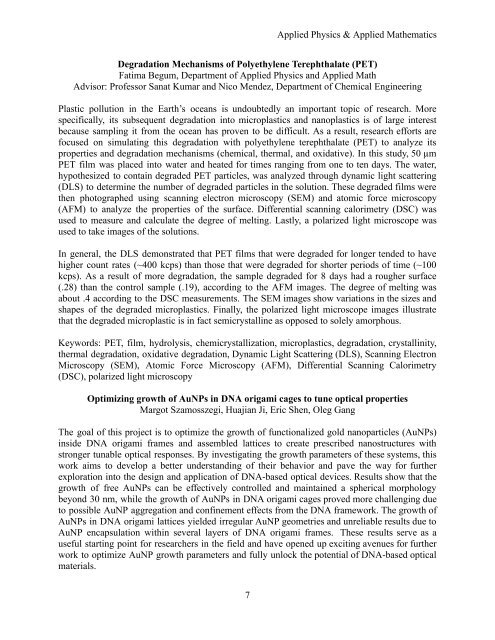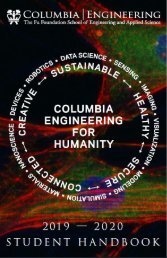You also want an ePaper? Increase the reach of your titles
YUMPU automatically turns print PDFs into web optimized ePapers that Google loves.
Applied Physics & Applied Mathematics<br />
Degradation Mechanisms of Polyethylene Terephthalate (PET)<br />
Fatima Begum, Department of Applied Physics and Applied Math<br />
Advisor: Professor Sanat Kumar and Nico Mendez, Department of Chemical Engineering<br />
Plastic pollution in the Earth’s oceans is undoubtedly an important topic of research. More<br />
specifically, its subsequent degradation into microplastics and nanoplastics is of large interest<br />
because sampling it from the ocean has proven to be difficult. As a result, research efforts are<br />
focused on simulating this degradation with polyethylene terephthalate (PET) to analyze its<br />
properties and degradation mechanisms (chemical, thermal, and oxidative). In this study, 50 µm<br />
PET film was placed into water and heated for times ranging from one to ten days. The water,<br />
hypothesized to contain degraded PET particles, was analyzed through dynamic light scattering<br />
(DLS) to determine the number of degraded particles in the solution. These degraded films were<br />
then photographed using scanning electron microscopy (SEM) and atomic force microscopy<br />
(AFM) to analyze the properties of the surface. Differential scanning calorimetry (DSC) was<br />
used to measure and calculate the degree of melting. Lastly, a polarized light microscope was<br />
used to take images of the solutions.<br />
In general, the DLS demonstrated that PET films that were degraded for longer tended to have<br />
higher count rates (~400 kcps) than those that were degraded for shorter periods of time (~100<br />
kcps). As a result of more degradation, the sample degraded for 8 days had a rougher surface<br />
(.28) than the control sample (.19), according to the AFM images. The degree of melting was<br />
about .4 according to the DSC measurements. The SEM images show variations in the sizes and<br />
shapes of the degraded microplastics. Finally, the polarized light microscope images illustrate<br />
that the degraded microplastic is in fact semicrystalline as opposed to solely amorphous.<br />
Keywords: PET, film, hydrolysis, chemicrystallization, microplastics, degradation, crystallinity,<br />
thermal degradation, oxidative degradation, Dynamic Light Scattering (DLS), Scanning Electron<br />
Microscopy (SEM), Atomic Force Microscopy (AFM), Differential Scanning Calorimetry<br />
(DSC), polarized light microscopy<br />
Optimizing growth of AuNPs in DNA origami cages to tune optical properties<br />
Margot Szamosszegi, Huajian Ji, Eric Shen, Oleg Gang<br />
The goal of this project is to optimize the growth of functionalized gold nanoparticles (AuNPs)<br />
inside DNA origami frames and assembled lattices to create prescribed nanostructures with<br />
stronger tunable optical responses. By investigating the growth parameters of these systems, this<br />
work aims to develop a better understanding of their behavior and pave the way for further<br />
exploration into the design and application of DNA-based optical devices. Results show that the<br />
growth of free AuNPs can be effectively controlled and maintained a spherical morphology<br />
beyond 30 nm, while the growth of AuNPs in DNA origami cages proved more challenging due<br />
to possible AuNP aggregation and confinement effects from the DNA framework. The growth of<br />
AuNPs in DNA origami lattices yielded irregular AuNP geometries and unreliable results due to<br />
AuNP encapsulation within several layers of DNA origami frames. These results serve as a<br />
useful starting point for researchers in the field and have opened up exciting avenues for further<br />
work to optimize AuNP growth parameters and fully unlock the potential of DNA-based optical<br />
materials.<br />
7








